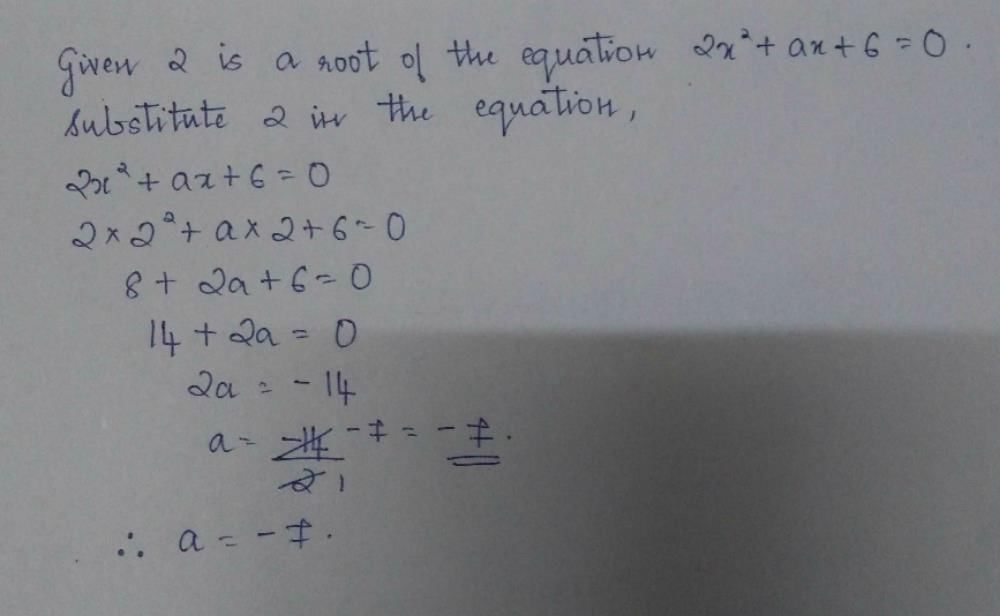Class 10 Exam > Class 10 Questions > If one root of the equation 2x2 ax 6=0 is ...
Start Learning for Free
If one root of the equation 2x2 ax 6=0 is 2 the a=?
Most Upvoted Answer
If one root of the equation 2x2 ax 6=0 is 2 the a=?
Answer
Let's begin by understanding the quadratic equation and its roots. A quadratic equation is a polynomial equation of the second degree. It can be written in the standard form as:
ax2 + bx + c = 0
where a, b, and c are constants and x is the variable. The roots of a quadratic equation are the values of x that satisfy the equation, i.e., they make the equation true. There are two roots of a quadratic equation, which can be real or complex.
Given Equation
Now, let's consider the given equation:
2x2 - ax + 6 = 0
We are told that one of the roots of this equation is 2. Let's use this information to find the value of a.
Finding the Second Root
Since the equation has two roots, we can use the following formula to find the second root:
x = (-b ± √(b2 - 4ac)) / 2a
Here, b = -a, a = 2, and c = 6 (from the given equation).
Substituting these values in the formula, we get:
2 = (-(-a) ± √((-a)2 - 4(2)(6))) / 2(2)
Simplifying this expression, we get:
2 = (a ± √(a2 - 48)) / 4
Multiplying both sides by 4, we get:
8 = a ± √(a2 - 48)
Finding the Value of a
Now, we have two equations based on the two possible values of the second root:
8 = a + √(a2 - 48)
8 = a - √(a2 - 48)
Squaring both sides of each equation, we get:
64 = a2 - 48 + 2a√(a2 - 48)
64 = a2 - 48 - 2a√(a2 - 48)
Adding 48 to both sides of each equation, we get:
112 = a2 + 2a√(a2 - 48)
112
Community Answer
If one root of the equation 2x2 ax 6=0 is 2 the a=?


|
Explore Courses for Class 10 exam
|

|
Similar Class 10 Doubts
If one root of the equation 2x2 ax 6=0 is 2 the a=?
Question Description
If one root of the equation 2x2 ax 6=0 is 2 the a=? for Class 10 2025 is part of Class 10 preparation. The Question and answers have been prepared according to the Class 10 exam syllabus. Information about If one root of the equation 2x2 ax 6=0 is 2 the a=? covers all topics & solutions for Class 10 2025 Exam. Find important definitions, questions, meanings, examples, exercises and tests below for If one root of the equation 2x2 ax 6=0 is 2 the a=?.
If one root of the equation 2x2 ax 6=0 is 2 the a=? for Class 10 2025 is part of Class 10 preparation. The Question and answers have been prepared according to the Class 10 exam syllabus. Information about If one root of the equation 2x2 ax 6=0 is 2 the a=? covers all topics & solutions for Class 10 2025 Exam. Find important definitions, questions, meanings, examples, exercises and tests below for If one root of the equation 2x2 ax 6=0 is 2 the a=?.
Solutions for If one root of the equation 2x2 ax 6=0 is 2 the a=? in English & in Hindi are available as part of our courses for Class 10.
Download more important topics, notes, lectures and mock test series for Class 10 Exam by signing up for free.
Here you can find the meaning of If one root of the equation 2x2 ax 6=0 is 2 the a=? defined & explained in the simplest way possible. Besides giving the explanation of
If one root of the equation 2x2 ax 6=0 is 2 the a=?, a detailed solution for If one root of the equation 2x2 ax 6=0 is 2 the a=? has been provided alongside types of If one root of the equation 2x2 ax 6=0 is 2 the a=? theory, EduRev gives you an
ample number of questions to practice If one root of the equation 2x2 ax 6=0 is 2 the a=? tests, examples and also practice Class 10 tests.

|
Explore Courses for Class 10 exam
|

|
Signup for Free!
Signup to see your scores go up within 7 days! Learn & Practice with 1000+ FREE Notes, Videos & Tests.


























